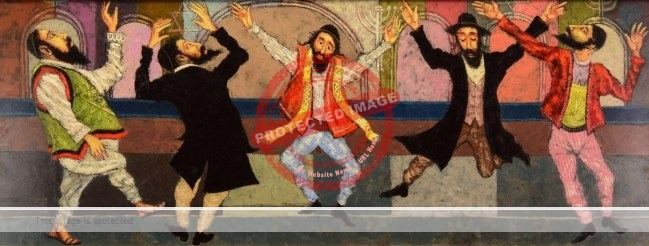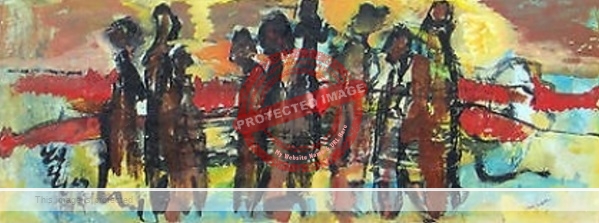Despite several popular art sites listing Bert Pumphrey’s exhibitions as including three in Ajijic, I have yet to find any details for them. Pumphrey’s distinctive work is so highly collectible, that he would certainly deserve a place among the Lakeside greats (and in the Ajijic Museum of Art) if his association with Lake Chapala can be proven.
The three exhibitions listed for Bert Pumphrey in Ajijic are:
- La Nueva Posada, Art Shows in the Garden, 1955
- Casa de la Cultura, Ajijic, Plaza Principal 1978
- Galeria AXIXICC, Ajijic, 1985
The 1955 entry clearly cannot be correct. Either this was an exhibit in the (Old) Posada Ajijic, or the year is inaccurate and it should be 1995. Either way, I have found no confirming evidence anywhere for this or the other two shows. If you can help, please get in touch!
Despite drawing a blank as regards the Ajijic exhibitions, my search for answers has enabled me to compile a more accurate account of Pumphrey’s life and work than those currently available on the web.

Bert Pumphrey. Undated. Un militar.
Bertrem (Bert) Pumphrey was born in Welby, Salt Lake City, Utah, on 30 January 1916. After graduating from Provo High School in 1936, Pumphrey took classes for a year at the Chicago Art Institute. From 1937 to 1941, he studied on a scholarship at the Chouinard Art Institute in Los Angeles, where he was strongly influenced by Henry Lee McFee and Tom Craig
At the second annual exhibit of Artists of Los Angeles and Vicinity (organized by Los Angeles County Museum) in 1941, Pumphrey’s painting “Rainy Season” and a work by famous Japanese-American modernist Sueo Serisawa received honorable mentions for painting.
In 1940, while still a student, Pumphrey had registered for military service, and after completing his studies the following year he enlisted in the army. He served as a surgical technician in the Army Medical Corps in Asia and the Far East
His first major group show after the war was at the Los Angeles Art Association in 1946, in a collective exhibition titled “They Have Returned,” with one critic writing that “Bertram Pumphrey’s oils of India convey that land’s rich decoration and vegetation and the accompanying poverty.”
Later that year in September Pumphrey held his first solo show (of 47 oil paintings) at the prestigious Palace of the Legion of Honor in San Francisco.
In 1947, Pumphrey had the first of at least two solo shows at the American Contemporary Gallery in Los Angeles. His 22 canvases were described by Los Angeles Times art critic Arthur Millier as “rich in color and human interest.” Millier also recorded that Pumphrey had “recently worked” with Tom Craig on a large mural or murals at the San Antonio Hospital, Claremont, and had completed a large 40′ by 12′ mural commission in a private Hollywood home.
In 1947-1948 Pumphrey taught art part-time at the Art Barn School of Arts in Salt Lake City, giving himself ample time to develop his own art while still having a reliable income.

Bert Pumphrey. Undated. Hasidic Rabbis Dancing.
Pumphrey moved to Mexico in 1948, and exhibited relatively infrequently in the US after that date, though he retained links with California, giving classes and participating in group shows in Lafayette and Oakland in 1954. By this time he had married Isabel. The couple apparently kept homes in both Tlalpan, a suburb of Mexico City and in California, dividing their time between the two places. Isabel became a naturalized US citizen in 1984 on her 54th birthday.
In 1955, Pumphrey painted murals depicting typical scenes from Bavarian villages on the walls of Sam’s Hof Brau in the historic Kost building in Sacramento. Four years later, he completed a large mural for the Seagulll Motel in Salt Lake City, assisted by his twin brother, Joe, who was also an artist.
His first major solo show in Mexico was at the Galería Pemex in Mexico City in January 1960. It included 106 works, in a variety of media, from oils on masonite and linoleum to watercolors and ink drawings, and of varied subjects, demonstrating the artist’s impressive versatility.
Pumphrey’s smaller solo show the following year at the Mexican-Northamerican Cultural Institute in Mexico City featured 19 oils and 17 watercolors; it included a self portrait alongside animal, coastal and jungle studies.
Pumphrey’s techniques and preferences changed markedly over the years. In 1971, the Oakland Museum showed a short film “Bert Pumphrey, Pleasanton Artist,” which depicted how Pumphrey liked to paint: using palette knives, including some of his own design, to cut through successive layers of paint to achieve the color, texture and form he wanted. (This technique was similar to that used for traditional lacquer work in Mexico). For these paintings, Pumphrey worked on masonite, rather than canvas, and on a table, rather than an easel.

Bert Pumphrey. 1969.
Pumphrey completed murals for several public buildings, clubs, churches and private homes in Mexico (presumably mainly in 1950s), as well as murals in the Kost building, Sacramento (1955) and the Seagull Motel, Salt Lake City (1959).
Bert Pumphreys’s confirmed group shows include Los Angeles Art Association (1946, 1947); Chaffey, Ontario, California (1947); Biblioteca Cervantes, Mexico City (1952); Artists’ Market, Oakland, California (1954) and Valley Art Center, Contra Costa, California (1955).
In addition to the three possible shows in Ajijic and one (also unconfirmed) in the Virgin Islands, Pumphrey’s solo shows included Palace of the Legion of Honor, San Francisco (1946); American Contemporary Gallery, Los Angeles (1947, 1948); Palette Club, Salt Lake City (1947); Galería Pemex, Mexico City (1960); lnstituto Mexicano-Norteamericano de Relaciones Culturales, Mexico City (1961); Little Gallery, Philadelphia (1967); Cory Gallery, San Francisco (1969); and La Cienega Gallery, Los Angeles (1971).
The artist spent his final years in South Pasadena, where he died on 20 June 2002.
Several chapters of Foreign Footprints in Ajijic: Decades of Change in a Mexican Village offer more details about the history of the artistic community in Ajijic.
Sources
- Bingham Bulletin 12 Sep 1941, 5; 3 Sep 1954, 3
- Contra Costa Gazette 11 Feb 1954, 5; 22 Jul 1955, 4
- Contra Costa Times 25 Feb 1954, 5
- Daily Herald 08 May 1936, 3
- Justino Fernández. (a) 1953 (b) 1961 (c) 1962. Catálogos de las Exposiciones de Arte en los años 1952, 1960 and 1961. Anales del Instituto de Investigaciones Estéticas, Mexico.
- Los Angeles Times 16 March 1941, 21; 16 March 1941, 21; 23 Mar 1941; 24 March 1946, 26; 6 Jul 1947, 26; 21 Sep 1947, 28; 04 Jul 1948, 45; 25 Jul 1971, 425
- Oakland Tribune 14 Feb 1954, 91; 31 Jan 1971, 125
- Pasadena Star-News. 2002. Bertrem Pumphrey (obituary). 29 June 2002.
- Philadelphia Inquirer 04 Jun 1967, 141
- Sacramento Bee 22 Jan 1955, 52
- Salt Lake Tribune 02 Nov 1947, 64; 10 Aug 1947, 48; 14 Dec 1947, 72; 12 Jul 1959, 29; 18 Oct 1964, 78
- San Francisco Examiner 29 Sep 1946, 135; 28 Dec 1969, 142
Comments, corrections or additional material related to any of the writers and artists featured in our series of mini-bios are welcomed. Please use the comments feature at the bottom of individual posts, or email us.
Tony Burton’s books include “Lake Chapala: A Postcard History” (2022), “Foreign Footprints in Ajijic” (2022), “If Walls Could Talk: Chapala’s historic buildings and their former occupants” (2020), (available in translation as “Si Las Paredes Hablaran”), “Mexican Kaleidoscope” (2016), and “Lake Chapala Through the Ages” (2008).